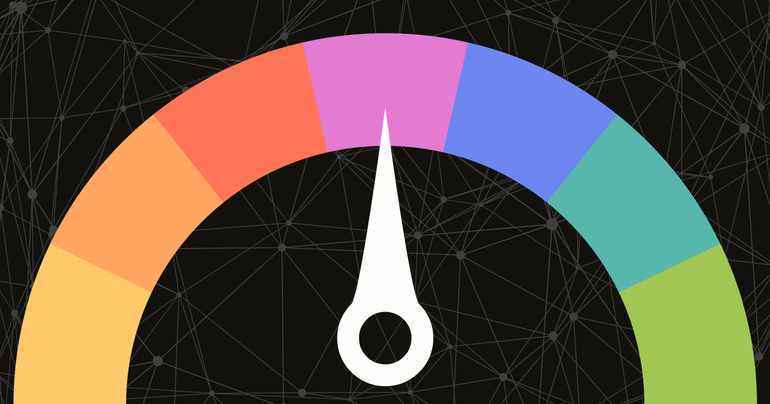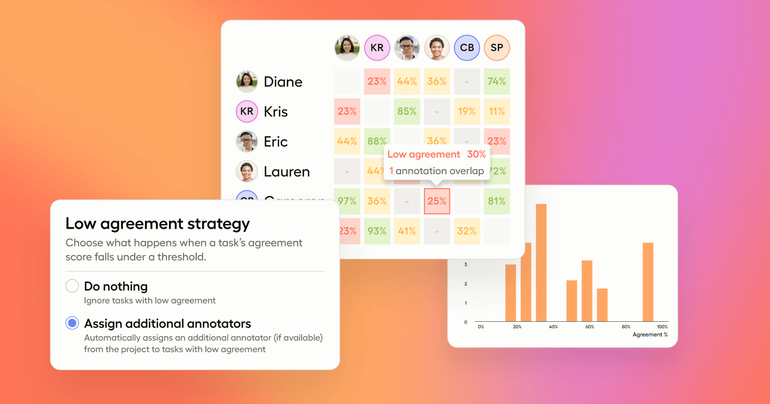-
 Guide How Legalbenchmarks.ai Built a Domain-Specific AI Benchmark
Guide How Legalbenchmarks.ai Built a Domain-Specific AI BenchmarkSee how Legalbenchmarks.ai built a custom contract-drafting AI benchmark using an SME-first, human-in-the-loop framework with rubric-based scoring and LLM judges.
 Sheree Zhang
Sheree ZhangSr. Product Manager
-
 Guide SAM2 vs YOLO for Bounding Box Labeling: Which Should You Use?
Guide SAM2 vs YOLO for Bounding Box Labeling: Which Should You Use?A practical comparison of SAM2 and YOLO for bounding box labeling, with pros, cons, and how to use each model in Label Studio.
 Micaela Kaplan
Micaela KaplanData Scientist
-
 Guide 9 Criteria for Successful AI Projects
Guide 9 Criteria for Successful AI ProjectsMost AI projects fail from unclear goals and poor alignment. These nine criteria show how to build systems that scale, adapt, and deliver value.
 David Hayes
David HayesVP of Product
-
 Guide The Virtuous Cycle of Using Your Brain Alongside GenAI - A Case Study
Guide The Virtuous Cycle of Using Your Brain Alongside GenAI - A Case StudyThis case study shows how human oversight turns AI missteps into opportunities for better systems, documentation, and long-term reliability.
 Alec Harris
Alec HarrisDirector of Product Management
-
 Guide Operationalizing Compliance with the EU AI Act’s High-Risk Requirements
Guide Operationalizing Compliance with the EU AI Act’s High-Risk RequirementsThe EU AI Act brings enforceable demands for transparency, oversight, and auditability, this guide shows how AI teams can meet them through robust infrastructure.
 HumanSignal Team
HumanSignal Team -
 Guide What Is a Spectrogram? Understanding Sound Beyond the Waveform
Guide What Is a Spectrogram? Understanding Sound Beyond the WaveformIn this post, we explore how spectrograms work and why they’re essential for analyzing speech, music, and machine learning audio data.
 Micaela Kaplan
Micaela KaplanData Scientist
-
 Guide Intro to Hidden Markov Models: When the State Is Hidden but the Signal Isn't
Guide Intro to Hidden Markov Models: When the State Is Hidden but the Signal Isn'tThis blog introduces the core components and algorithms behind HMMs, from decoding hidden states to calculating sequence likelihoods.
 Micaela Kaplan
Micaela KaplanData Scientist
-
 Guide Data Labeling with GPT-4 in Label Studio: ML Backend Integration
Guide Data Labeling with GPT-4 in Label Studio: ML Backend IntegrationThis blog shows how to integrate GPT-4 with Label Studio to shift from manual labeling to faster label review. Use OpenAI’s API and the ML Backend to streamline text annotation and accelerate NLP workflows.
 Jimmy Whitaker
Jimmy WhitakerData Scientist in Residence at HumanSignal
-
Never miss
an update.Subscribe for news.
-
 Guide How to Label Spectrograms for AI Models
Guide How to Label Spectrograms for AI ModelsYou can now label audio data for training or fine-tuning AI models using spectrograms. This blog outlines why you might use spectrograms and how to use them in Label Studio.
 Micaela Kaplan
Micaela KaplanData Scientist
-
 Guide Markov Models: Chains to Choices
Guide Markov Models: Chains to ChoicesThis post breaks down Markov Chains and Markov Decision Processes with intuitive examples and a video walkthrough.
 Micaela Kaplan
Micaela KaplanData Scientist
-
 Guide Your Data Engine Is the Moat – Here’s How to Own It.
Guide Your Data Engine Is the Moat – Here’s How to Own It.Model weights can be rented, but your feedback loop is the moat. This blog explains how leading AI teams are reclaiming control over labeling, evaluation, and iteration, without sacrificing speed.
 Michael Malyuk
Michael MalyukCEO & Co-Founder
-
 Guide The Rise of Real-World Robotics—and the Data Behind It
Guide The Rise of Real-World Robotics—and the Data Behind ItRobots need labeled data to navigate the real world. This blog explores why robotics annotation is uniquely complex and how teams can get it right.
 HumanSignal Team
HumanSignal Team -
 Guide Who Watches the Watchdogs? Evaluating LLM-as-a-Judge
Guide Who Watches the Watchdogs? Evaluating LLM-as-a-JudgeMeasure annotator agreement with Krippendorff’s alpha,even on incomplete data. This guide walks through a real example and explains what the results mean.
 Micaela Kaplan
Micaela KaplanData Scientist
-
 Guide How to Use Krippendorff’s Alpha to Measure Annotation Agreement
Guide How to Use Krippendorff’s Alpha to Measure Annotation AgreementLearn how to calculate Krippendorff’s alpha to measure annotator agreement, even with missing data. This guide walks through a real example step by step.
 Micaela Kaplan
Micaela KaplanData Scientist
-
 Guide Everybody Is (Unintentionally) Cheating
Guide Everybody Is (Unintentionally) CheatingAI benchmarks are breaking under pressure. This blog explores four ways to rebuild trust, governance, transparency, better metrics, and centralized oversight.
 Nikolai Liubimov
Nikolai LiubimovCTO
-
 Guide 3 Annotation Team Playbooks to Boost Label Quality and Speed
Guide 3 Annotation Team Playbooks to Boost Label Quality and SpeedNot every ML team looks the same and your labeling workflow shouldn’t either. In this guide, we break down three common annotation team setups and how to tailor your tools and processes to boost quality, speed, and scale.
 Alec Harris
Alec HarrisDirector of Product Management
-
 Guide Seven Ways Your RAG System Could be Failing and How to Fix Them
Guide Seven Ways Your RAG System Could be Failing and How to Fix ThemThis post explores seven common RAG failured, from missing top-ranked documents to incorrect formatting, and provides practical solutions to improve retrieval accuracy, ranking, and response quality.
 Micaela Kaplan
Micaela KaplanData Scientist
-
 Guide Evaluating Mistral OCR with Label Studio
Guide Evaluating Mistral OCR with Label StudioMistral OCR is setting a new standard for document understanding, but how well does it perform on your data? Using Label Studio, you can evaluate its accuracy, compare outputs, and fine-tune results. In this post, we walk through the process and share a hands-on handbook to get started.
 Micaela Kaplan
Micaela KaplanData Scientist
-
 Guide Reinforcement Learning from Verifiable Rewards
Guide Reinforcement Learning from Verifiable RewardsLearn about Reinforcement Learning with Verifiable Rewards, one of the leading training strategies for injecting learning signals into LLMs, successfully employed by models such as DeepSeek R1 and Tülu 3.
 Nikolai Liubimov
Nikolai LiubimovCTO
-
 Guide Content Moderation Labeling with Label Studio
Guide Content Moderation Labeling with Label StudioGet started with content moderation labeling to classify potentially harmful data for training purposes, or evaluate the output of a model you already have in place.
 Micaela Kaplan
Micaela KaplanData Scientist
-
 Guide Evaluating Multi-Turn LLM Chat Conversations Using Label Studio
Guide Evaluating Multi-Turn LLM Chat Conversations Using Label StudioEvaluating multi-turn conversations with Label Studio helps identify performance gaps, refine responses, and improve user experience for a more effective virtual assistant.
 Jimmy Whitaker
Jimmy WhitakerData Scientist in Residence at HumanSignal
-
 Guide Fine-Tuning OpenAI Models: A Guide with Wikipedia Data
Guide Fine-Tuning OpenAI Models: A Guide with Wikipedia DataGo through the entire fine-tuning process on OpenAI’s platform—from preparing recently-posted Wikipedia data to estimating costs and deploying your fine-tuned model.
 Jimmy Whitaker
Jimmy WhitakerData Scientist in Residence at HumanSignal
-
 Guide Webhooks in Label Studio: When And How To Use Them
Guide Webhooks in Label Studio: When And How To Use ThemLearn when you should use webhooks vs. the API in Label Studio, and see examples of what you can do with webhooks.
 Caitlin Wheeless
Caitlin WheelessTechnical Writer
-
 Guide Object Detection With Ultralytics YOLOv8
Guide Object Detection With Ultralytics YOLOv8Learn how to use Ultralytics YOLOv8 object detection model with Label Studio.
 HumanSignal Team
HumanSignal Team -
 Guide LLM Evaluations: Techniques, Challenges, and Best Practices
Guide LLM Evaluations: Techniques, Challenges, and Best PracticesExplore the topic of evaluation for LLMs, its importance, and how we should approach it. Learn how integrating systematic evaluations can help teams iteratively refine their models to meet real-world needs.
 Jimmy Whitaker
Jimmy WhitakerData Scientist in Residence at HumanSignal
-
 Guide How to Build and Evaluate RAG Applications with Label Studio, OpenAI & Ragas
Guide How to Build and Evaluate RAG Applications with Label Studio, OpenAI & RagasIn this tutorial, we'll guide you through the process of setting up and using Label Studio in combination with Ragas (Retrieval-Augmented Generation Answer Scoring) and GPT-4 to build an optimized QA application.
 Jo Booth
Jo BoothSenior Full Stack Engineer
-
 Guide Key Considerations For Evaluating RAG-Based Systems
Guide Key Considerations For Evaluating RAG-Based SystemsImplementing RAG-based systems comes with challenges to be aware of, particularly in assessing the quality of generated responses. This article will walk you through some of those challenges.
 Jo Booth
Jo BoothSenior Full Stack Engineer
-
 Guide 3 Ways To Automate Your Labeling With Label Studio
Guide 3 Ways To Automate Your Labeling With Label StudioDelve into three effective methods to automate your labeling using Label Studio, including examples and resources.
 Nate Kartchner
Nate KartchnerDirector of Marketing
-
 Guide LLM Evaluation: Comparing Four Methods to Automatically Detect Errors
Guide LLM Evaluation: Comparing Four Methods to Automatically Detect ErrorsAn ongoing challenge for Large Language Models (LLMs) is their tendency to hallucinate. In this article, we explore four methods to automatically detect these errors.
 Nikolai Liubimov
Nikolai LiubimovCTO
-
 Guide Do I Need to Build a Ground Truth Dataset?
Guide Do I Need to Build a Ground Truth Dataset?The short answer is: it depends. Read on as we explore this topic further, uncovering the advantages and drawbacks of each approach to help you make an informed decision.
 Label Studio Team
Label Studio Team -
 Guide Enhancing Data Quality with Label Studio Automated Workflows
Guide Enhancing Data Quality with Label Studio Automated WorkflowsThis post will take you through the intricacies of data quality, the strategies employed to build top-tier datasets, and how to use Label Studio Enterprise to engineer your AI/ML success.
 Label Studio Team
Label Studio Team -
 Guide What’s a Ground Truth Dataset?
Guide What’s a Ground Truth Dataset?Understanding the distinction between regular datasets and ground truth datasets is crucial for leveraging data effectively in machine learning and data analysis tasks. This article explores both concepts and digs deeper into the importance of ground truth datasets.
 Label Studio Team
Label Studio Team -
 Guide Fine-Tuning Generalist Models for Named Entity Recognition
Guide Fine-Tuning Generalist Models for Named Entity RecognitionGeneralist models, like GLiNER, provide an excellent starting point for the tasks that they aim to solve. Fine-tuning these models offers us a way to improve their performance in the areas that we care about to solve business problems.
 Micaela Kaplan
Micaela KaplanData Scientist
-
 Guide Strategies for Evaluating LLMs
Guide Strategies for Evaluating LLMsSure, benchmarks are cool, but they don’t give you the feel or the intuition of how a model actually works. To get that, you’ve got to hack around with the model and throw real-world prompts at it — like you’d do in day-to-day tasks.
 Label Studio Team
Label Studio Team -
 Guide 5 Tips and Tricks for Label Studio’s API and SDK
Guide 5 Tips and Tricks for Label Studio’s API and SDKThese five tips for using Label Studio's API and SDK demonstrate these tools' powerful capabilities and flexibility for managing data labeling projects. From efficient project creation and task imports to advanced configurations and bulk data exports, Label Studio provides a comprehensive and streamlined approach suitable for beginners and advanced users.
 Jimmy Whitaker
Jimmy WhitakerData Scientist in Residence at HumanSignal
-
 Guide An Introduction to Retrieval-Augmented Generation (RAG)
Guide An Introduction to Retrieval-Augmented Generation (RAG)Get a brief overview of RAG and how it relates to LLMs, learn when you might consider using RAG, and get a summary of some challenges based on current research you should be aware of should you choose to travel down this path.
 Nate Kartchner
Nate KartchnerDirector of Marketing
-
 Guide Medical Data Labeling and Label Studio
Guide Medical Data Labeling and Label StudioFrom precise disease diagnoses to personalized treatment plans, accurately labeled data profoundly impacts healthcare. This guide explores the fundamentals of medical data labeling, its applications, and its evolution through AI.
 Label Studio Team
Label Studio Team -
 Guide 10 Tips to Supercharge Your Data Labeling Efficiency
Guide 10 Tips to Supercharge Your Data Labeling EfficiencyWhen training Large Language Models and utilizing machine learning, the significance of precise and efficient data labeling cannot be overstated. Here are ten actionable tips to elevate your data labeling processes.
 Label Studio Team
Label Studio Team -
 Guide Four Pillars of an Optimal Data Labeling Process
Guide Four Pillars of an Optimal Data Labeling ProcessThe realm of data labeling is undergoing significant transformations, reflecting the dynamic nature of the tech industry. Here are some of the most notable trends and their implications.
 Label Studio Team
Label Studio Team -
 Guide Enhance Your Data Labeling Workflow With a Machine Learning Backend
Guide Enhance Your Data Labeling Workflow With a Machine Learning BackendIntegrating a machine learning (ML) backend into the data labeling process for a labeling platform can significantly enhance the efficiency and accuracy of the process.
 Label Studio Team
Label Studio Team